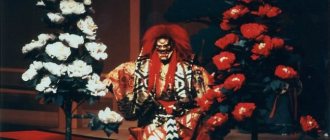The Japanese have long opened the doors of their isolated island to residents of Western countries, but this has not made them any clearer. Japanese culture, developed over centuries, is a mixture of Buddhist and Shinto principles, often embodied in frightening stories of monsters, ghosts and other paranormal beings. At first it seems that local urban legends have a very “Western” form, but this is only a superficial look at the problem. If a vengeful ghost appears in Japanese history, then the heroes have absolutely no chance to resist it; if a Japanese author needs to instill fear in readers, then he will not release a bloody corpse onto the stage: much more than zombies or skeletons, the Japanese will be frightened by a violation of the usual order things - television interference, a crumpled lantern or a vase out of place. But the most unusual thing for Western readers is the prohibitive amount of understatements. For us, an open ending in a horror story is already an out-of-the-ordinary event, but what can you say about an open beginning or an open climax? The Japanese author will definitely end the story in the most unexpected place - this is what the Buddhist principle of yugen - the principle of understatement, thinking through, and intuitive understanding of the essence of things - tells the Japanese. This principle in Japanese legends goes hand in hand with a special attitude towards death, the search for harmony with the surrounding world, and admiration of sadness. Due to the peculiarities of the Japanese attitude to life, many stories from the Land of the Rising Sun seem too calm, leisurely and naive to Europeans, while other legends, on the contrary, are seen as too bloody, cruel and hopeless. Now we will remember five stories from the second category. Get some privacy, turn off the lights and get started. And then be more careful with trips to the toilet and night walks.
Nure-onna
A lonely traveler wanders along a deserted sandy beach. Deeply immersed in his thoughts, he gazes unseeingly at the waves weakly beating against the shore. Now he will reach his favorite place, take off his clothes and plunge into the friendly sea. But suddenly his attention is attracted by a black spot on the water. Taking a closer look, the traveler realizes that this is a woman’s hair. With the last of her strength, the unfortunate woman turns her pale, pleading face towards him and slowly goes under the water. The traveler, without hesitation, rushes after the drowning woman. He quickly swims to the scene of the tragedy (strangely, it’s not deep here at all), and suddenly his body goes numb. A woman pops up nearby, her face no longer seems pleading to the traveler - it is angry and frightening, with frankly snake-like features. Something grabs the man's body - for a second it may even seem that the drowning woman is trying to save him. But no: the traveler’s body was wrapped not in arms, but in the huge slimy body of a snake. With a terrible smile, the woman bends over her cold victim and extends her long forked tongue towards her.
The unfortunate traveler was unlucky - he met an evil youkai named Nure-onna, which translated means “wet woman”. There are two varieties of this monster: the first looks like a snake with a woman's head, and the second is indistinguishable from a simple girl. Both are strong enough to simply attack people, but prefer to capture victims by cunning. Nure-onna in her female form always holds in her hand a bundle resembling a baby. She approaches the victim and asks him to hold the child for a while while he rests. Since the woman looks soaking wet and tired to death, she is usually not refused. As soon as the victim takes the package, it instantly turns into a heavy load that does not allow the person to budge. Here Nure-onna reveals her serpentine essence, grabs the victim and sucks all the blood out of her with her tongue. One of the retellings of this legend says that the monster does not kill people with pure intentions, but it seems that the Japanese themselves do not really believe in this. Another version also says that Nure-onna laughs terribly and to avoid immediate death, you must laugh with her. But even here no one promises you salvation: perhaps you will simply exchange immediate death for slow death.
Takashi Miike
Another well-known Japanese author who organically combines mysticism and torn out entrails in his films. He has been actively working in the genre since the late 1990s, when his first hit “Screen Test” was released, which quickly became a cult not only in Japan, but also abroad. He is extremely efficient, releasing 2-3 films a year: the last one - “The Terrible Will of the Gods” - was just recently released.
Hanako-san
This school toilet is rarely used by anyone, especially during classes or in the evening, when there is absolutely no one here. Only cleaners and brave teenagers disturb the local silence twice a day. And now - recess began, the door swung open sharply, almost flying off its hinges, and let a group of giggling schoolchildren inside. One girl from the group - the smallest and most frightened - was left to guard the door from outside. The schoolchildren jostled a bit at the entrance, then ran away to the other end of the room, leaving only one boy at the door. He shifted from foot to foot and laughed, but his voice trembled slightly. Then he suddenly fell silent and slowly moved towards the third booth. The laughter of his comrades also gradually faded away. The boy stopped in front of the door and, freezing for a second, knocked three times weakly. The toilet became completely quiet. He flinched and knocked on the door one more time.
“Are you here, Hanako-san?” - he asked.
Some of the teenagers barely audibly moved towards the exit, but the faint rustling of their steps was drowned out by tense silence.
“Yes, I’m here,” answered an eerie hoarse voice coming from the booth.
This was enough to provoke the flight of a good half of the company. The bravest of the teenagers stopped behind the boy at the booth and shouted to him: “Come on, open it!” He, already thinking little, mechanically extended his hand to the door and sharply opened it. In the booth stood a girl of about ten years old in a red skirt and white blouse. Her shiny black hair barely reached her shoulders. Seeing the ghost, the remaining brave souls immediately rushed to run, and only the boy at the booth was unable to move. The girl climbed into the toilet and extended her endlessly long white arms towards him.
Favorite Japanese urban legends involve toilet ghosts. Hanako-san is the most common and popular of them. A little girl in a red skirt began her triumphant march through school toilets in the 50s of the 20th century. There are different legends about the reasons for its appearance. Somewhere they say that Hanako died during the Second World War during the bombing of the city. Others claim that the girl was killed by her distraught mother. Hanako's father cheated on his wife and left the family, after which the schoolgirl's mother decided to kill herself and all her children. She quickly reached Hanako's brother and sister, but the girl herself managed to escape and hide in the school toilet. Her mother spent a long time looking for her around the school, but did not look into the right booth. She would have left with nothing, but finally decided to ask the watchman if he had seen her daughter. The watchman saw it. Her mother killed Hanako right in that booth and hanged herself nearby. The stories about Hanako's death don't stop there. Other versions include: a heart attack, an accident during a game, suicide, murder by one’s own father. Each school has its own legend about the unfortunate girl, but all the storytellers agree on one thing: Hanako died in their school and is buried somewhere on its territory. In almost all stories, the girl wears a red skirt, white blouse and dark bob.
Hanako-san is generally shy and quite harmless. To see her, you need to call her - knock on the desired booth a certain number of times (three or four) and ask a specific question. The ghost quite rarely kills summoners, especially if they offer him a game. To end up drowned in a toilet, you need to act as carelessly as the guy from the story above: ask Hanako if she is here, and after an affirmative answer, disturb her peace.
But Hanako has a much more evil and cruel “brother” - the toilet ghost Aka Manto, or Red Cloak. There is no need to call this friend anywhere - he will come himself when you are busy with important matters in your cubicle. Aka Manto will approach a locked door and burst into your life with a paradoxical question: “Red or blue cloak?” If, after a short confusion, you answer “red,” then Aka Manto will cut off your head so that the blood flowing from the wound forms some kind of eerie resemblance to a red cloak, and if you answer “blue,” then the ghost will simply strangle you so that your face acquires the appropriate shade. An attentive reader will exclaim: “But you can simply not answer him or name a different color!” Yes, perhaps this will save you from imminent death, but, most likely, the ground will simply open up under you and you will go straight to hell.
Dead girls in urban legends
A little dead girl or a young girl who haunts the living... In fact, this is not a Japanese idea, but a fairly common image that has inspired awe in impressionable people for years. In the West, there is a widespread urban legend about Bloody Mary, who can be summoned by looking in the mirror. The East offers not only Hanako-san to be scared, the ghost girl is generally a well-selling brand on which an entire industry of fear is built.
Even if you go through the cinema, you will immediately remember Sadako crawling out of the well in the film “The Ring”. But there is also Kashima Reiko (Teke-teke), running on her hands because she has no lower torso, Okiku doll with living hair, Kaori-san, biting off her ears along with earrings, a girl with a slit mouth, spider women, snake girls and so on.
Cow head
To calm the schoolchildren down, the teacher told them scary stories every trip. He had a real gift as a storyteller - from the very first words, the children fell silent and listened to him carefully, reacting emotionally to every turn of the story. The children were truly scared, but this fear was pleasant and desirable - they wanted to experience it on a dark bus and throw it off themselves when going out into the street. Today the teacher decided to tell his students the scariest story in his arsenal - the tale of the Cow's Head. Hearing the name of the story, the children became seriously tense: everyone in Japan had heard about the Cow's Head - the most terrible story on the planet. This legend is so terrible that it cannot be found in any book, and everyone who heard it after a while went crazy and attempted suicide. The children grinned incredulously: their teacher was, of course, a gifted and enthusiastic storyteller, but he simply could not know this story. The teacher, meanwhile, began: “This story happened before the Kan-ei period, but no one knows exactly when. In one village there lived a young woman. Her husband, who left early, left her a son, a tiny cold hut and a cow. Dying, he bequeathed...” Never in their lives have children listened to their teacher as carefully as they do now. The further the story progressed, the more noticeably they trembled. The first screams and sobs were heard. The schoolchildren covered their ears and crying begged the teacher to stop, but he no longer heard them - the narrator’s eyes glazed over, his mouth moved mechanically, spewing out terrible words. It seemed that he would continue the story even if his heart was torn out of his chest. The story was approaching a terrible ending: “A headless woman entered the killer’s hut, holding an ax with one hand and leading her runaway son with the other. She said to the boy: “Well, why did you run away? After all, you betrayed your mother. Why didn’t you die next to her?..” And suddenly the bus braked sharply. The teacher came to his senses from a painful blow to the chair. He ran up to the driver and saw that the latter - a huge man completely impervious to scary stories - was sitting in a semi-fainting state, covered in sweat, with his arms shaking. Probably out of fear, his foot on the brake jerked and saved everyone from the accident. The teacher returned to the salon and saw that all the children were lying unconscious, foam was dripping from their mouths onto their clothes and onto the floor.
As you already understand, the tale of the Cow's Head simply does not exist: for several centuries the Japanese have been spreading a legend about a certain story, which in itself has supernatural destructive power. As a rule, in Japanese books you will not find even a hint about what kind of story this is - it is so terrible that any mention can drive the reader or listener crazy. But of course, many (mostly Europeans) tried to create a legend about the Cow's Head. An excerpt from such a hoax is in the story above.
Nobuo Nakagawa
One of the fathers of Japanese horror, similar to Roger Corman, Jesus Franco and Mario Bava at the same time. Nakagawa actively used European and American techniques in his paintings (“House of the Phantom Cat,” “Lady Vampire”), but placed them in a traditional Japanese context, achieving their organic interweaving.
Kayako Saeki
Kayako Saeki had a truly difficult childhood. She was raised by her grandmother, who worked part-time as a retired shaman-exorcist. By doing good for strangers, she slowly destroyed her own granddaughter. Grandmother Kayako exorcised evil spirits from clients by taking infected blood from their tongues. Instead of draining this blood somewhere in the backyard of harmful neighbors, the kind grandmother gave it to little Kayako. Everything was going wrong in the girl's life. Classmates did not accept the strange, downtrodden girl with pale skin, dark eyes, scars and long black hair, and her first love, of course, turned out to be unhappy. It seemed that Kayako was doomed to the fate of a cursed, outcast hermit. But suddenly a man appeared who could fall in love with the unfortunate Kayako. Family life clearly benefited the girl: there was no trace left of the awkward, creepy teenager, reminiscent of the yurei from Japanese legends. Now no one could recognize the beautiful young woman as a vessel for evil spirits. Kayako gave birth to a son, the son grew up and went to school. By an evil coincidence, the teacher of Kayako’s son became the same man with whom the girl once fell in love. Hardly suppressed feelings flared up with renewed vigor. Kayako has long ceased to be a cursed teenager, who knows, maybe now everything will turn out differently... She could only share her experiences with a diary, but diaries are poor secret keepers. The husband found out about Kayako’s feelings and decided to punish the unfaithful woman in the only way available to him. He broke his wife's ankle when she returned home and watched with pleasure as she crawled up the stairs, trying to escape. But at the end of the stairs it was not salvation that awaited her, but a terrible death. The husband broke his begging wife's neck, listening to the terrible wheezing sounds she made before dying. Having thrown Kayako's body into a garbage container, the husband returned to the house and drowned his son, who witnessed the brutal murder. Following his son, his beloved black cat went to the next world.
When committing these inhumane crimes, the man did not take into account two things. Firstly, he lives in Japan, and here people who die a violent death have a habit of turning into evil, vengeful spirits - yurei or onre. Secondly, in his wife, even before her death, there existed a number of extremely unpleasant entities, which after death turned her into a very vindictive and vindictive lady. The first to fall at the hands of the powerful yurei, of course, was the jealous husband, and then all the other people who accidentally found themselves within Kayako’s sphere of influence. Her son and cat were also not left without work after death - they are the ones the ghost intends to kill. In approximately 100% of cases he succeeds.
This story from the movie "The Grudge" quite accurately conveys the nature of the yurei. No mercy, no hope - a meeting with a vengeful spirit brings painful death to anyone who comes across it. Kayako prefers brute physical force: she strangles her victims with hair growing from the ceiling, or breaks their bones in a particularly cruel way as a reminder of how she herself died. But other ghosts act much more subtly: their victims die mainly from horror. Previously, yurei were distinguished from other ghosts by the absence of legs - they appeared in the guise of a figure in funeral clothes and with a transparent ball instead of a face in which one eye floated. Now the absence of legs is an optional condition. Yuree walk barefoot or even wear shoes in order to frighten the living with their steps. They move deftly, quickly and in a very unique way - you can get a complete picture of this by watching at least one part of the Japanese “Curse”.
Ghost Popularity
The popularity and prevalence of this urban legend is simply amazing. In every city, people believe that this tragedy happened in their city, and willingly report new “true” details. This turned out to be quite enough for the creepypasta “Hanako-san” to gain incredible popularity.
The story appears in manga, anime and feature films, and at least four film adaptations have taken the story as a central plot.
In 2013, director Mafasumi Yamada made a feature-length film about Hanako, which is entirely based on this legend. In the anime series Scary Stories from School (1994), there are several episodes in which a ghost girl from the toilet appears.
Ghost stories are a fertile topic for creativity, so Hanako will appear on the screen more than once. Considering that Japanese filmmakers know how to scare the public like no other, then you can expect new products and be afraid of visits to the bathroom in advance.











